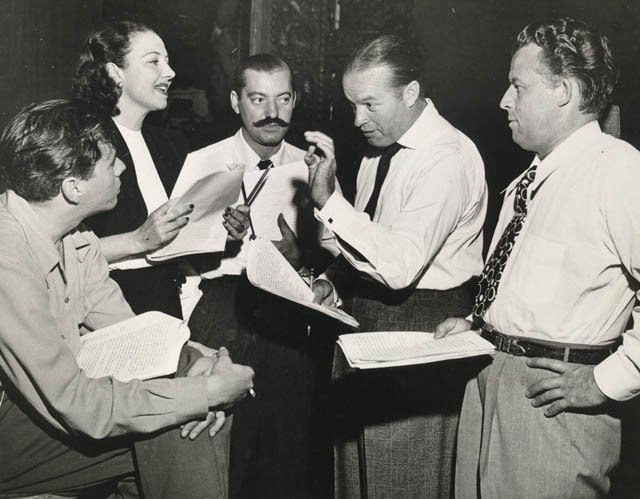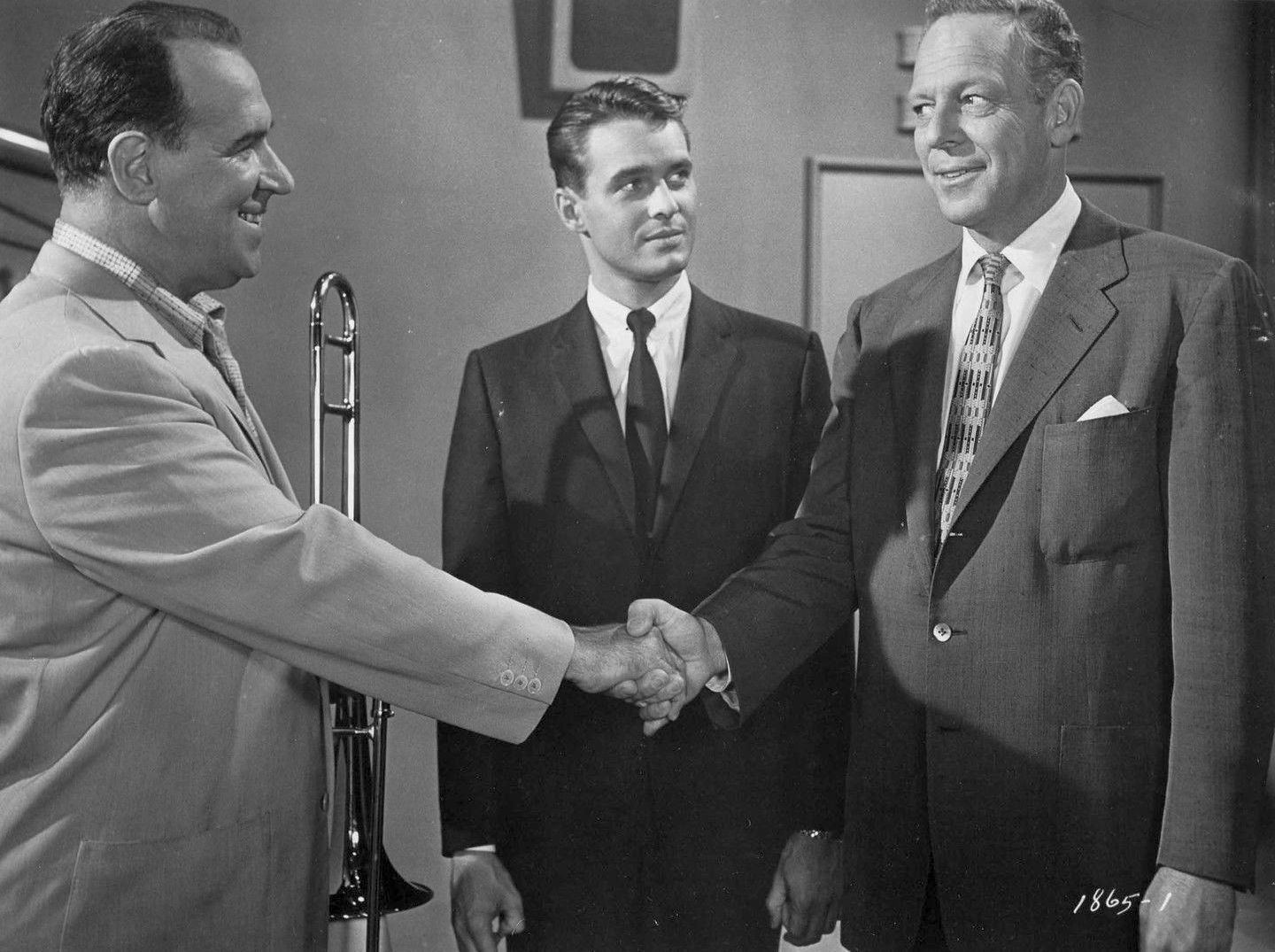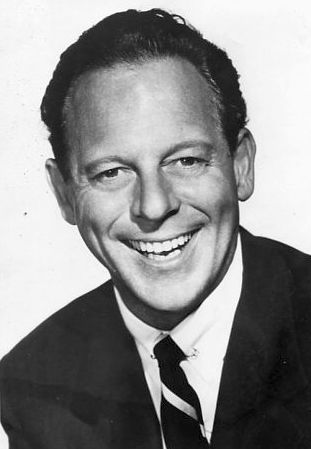Happy Birthday, Bill Goodwin!
Posted by Ivan G. Shreve, Jr. on Jul 28th 2014
There are announcers…and there are personality announcers. The latter were integral to the success of any comedy program during Radio’s Golden Age; not only did they dutifully promote the sponsor’s product, but they were also called upon to play a more participatory role in the weekly shenanigans in the show. Don Wilson, when he wasn’t hawking Jell-O or Grape Nuts or Lucky Strike, was important to the plot that unfolded during each half-hour of The Jack Benny Program. Harlow Wilcox stopped by 79 Wistful Vista each week not only to praise Johnson’s Wax or Carnu, but to needle the laird and master of that residence, Fibber McGee. Harry Von Zell was a foil for Fred Allen, Eddie Cantor, Joan Davis and Dinah Shore before becoming the whipping boy on George Burns and Gracie Allen’s popular TV sitcom.
Since I’ve mentioned Burns and Allen, it seems only fitting to mention that their longtime announcer Bill Goodwin celebrates what would have been his one-hundred-and-fourth birthday today. Born William Nettles Goodwin in San Francisco in 1910, Bill can be heard working alongside George and Gracie as early as an extant September 26, 1934 broadcast (when the couple’s show was known as The Adventures of Gracie and was sponsored by White Owl cigars). But he moonlighted with other funsters at the same time, working for Joe Penner’s Cocomalt show and at Jack Oakie’s College (which also meant that he handled the announcing chores for Oakie’s companion program, The Camel Caravan with Benny Goodman). Bill was also the announcer for Hollywood Showcase briefly in 1938, and yucked it up with Arthur Lake and Penny Singleton when those two brought their movie act to radio in the sitcom Blondie.

Goodwin’s best known radio gig at that time was as announcer and stooge for Bob Hope, whom he worked with during the comedian’s early years in radio (1938-41), and later rejoined in the 1950s (after George and Gracie chose to concentrate solely on TV). Because Bill was Bob’s announcer, it only made sense that he fill the same role on A Date with Judy when that sitcom was Hope’s summer replacement in 1941. Throughout the 1940s, Bill Goodwin would work alongside the likes of Edgar Bergen (and Charlie McCarthy), Milton Berle (on Three Ring Time), Gracie Fields, Al Pearce and Frank Sinatra. In select summers (because he was employed by Burns and Allen), he handled the chores on Tommy Riggs and Betty Lou and Paul Whiteman Presents. Other shows on which Bill made appearances include Command Performance, Mail Call, The Columbia Workshop, The Silver Theatre and The Lady Esther Screen Guild Theatre.
As George and Gracie’s announcer and foil, Bill Goodwin was a master of the integrated commercial—sneaking in plugs for Swan Soap and Maxwell House Coffee with effortless aplomb. Bill was also a sounding board for Gracie’s weekly bit of wacky and loved to toss barbs at George…usually on the subjects of his age and how he owed much of his success to his wife. Goodwin also fancied himself quite the ladies’ man and would offer up his expertise on charming the fairer sex to bandleader Meredith Willson, who was a complete washout where women were concerned.

Because of his popularity on the Burns and Allen program, Bill Goodwin attempted to strike out on his own in two unsuccessful solo ventures. He played an insurance salesman on CBS’ The Bill Goodwin Show (also known as Leave it to Bill), but despite the presence of radio veterans like Jim Backus, Bill Johnstone, Shirley Mitchell, Elvia Allman and Mary Jane Croft, the sitcom came and went rather quickly. The following year, Bill sent up the private eye genre as an inept (and inebriated) gumshoe named Johnny Fletcher, heard briefly on ABC (and co-starring Sheldon Leonard). A quiz show, Dollar a Minute, was hosted by Mr. G for a single season from 1950-51. Of course, by that time Bill was touting Carnation Milk on George and Gracie’s behalf on the small screen, so he certainly wasn’t browsing the want ads for work.
Besides, Bill Goodwin was already hard at work establishing his bona fides as a movie character actor. Amusingly, he turns up in two entries in the Blondie franchise (so it must have seemed like Old Home Week for Bill, Penny and Arthur), Blondie in Society (1941) and Blondie Goes to College (1942). You’ll recognize him as the hotel detective in Spellbound (1945), and as Olivia de Havilland’s business partner in To Each His Own (1946), the film that won Livvy her first of two Best Actress Oscars. Other Goodwin performances can be viewed in Incendiary Blonde (1945), The Stork Club (1945), The Jolson Story (1946), It’s a Great Feeling (1949), The Life of Riley (1949), Tea for Two (1950), Lucky Me (1954) and The Opposite Sex (1956). A film that’s been previously discussed here on the blog, So This is New York (1948), also includes Bill Goodwin among the all-star cast (as a megalomaniacal Broadway star)…and was recently released to DVD and Blu-ray this month by Olive Films.

It’s quite ironic that Bill Goodwin, who garnered appreciative laughs by ridiculing his boss George Burns’ age, would actually leave this world for a better one before his famous employer—Goodwin died of a heart attack in 1958 at the age of 47. But his underrated prowess as a comedic straight man lives on in such Burns & Allen Radio Spirits collections as Treasury, As Good as Nuts and Burns & Allen and Friends. (Bill gets plenty of time to say a few words in Volumes 1 and 2 of their television show, too.) And for a change of pace…our birthday boy shares a microphone with Bergen and McCarthy in the set Homefront Charlie. Happy birthday, Bill—you’re good to the last drop!

